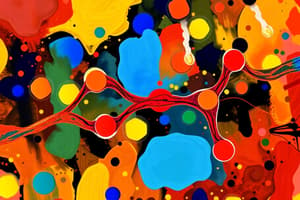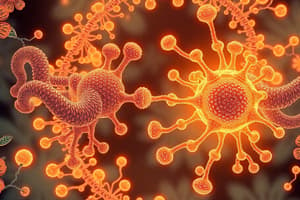Podcast
Questions and Answers
What is the term for the maximal degree of effectiveness of a drug, also known as intrinsic activity?
What is the term for the maximal degree of effectiveness of a drug, also known as intrinsic activity?
- Efficacy (correct)
- Therapeutic Index
- Affinity
- Potency
Which type of drug binds to the receptor but does not produce an effect, and has three subtypes: physical, chemical, and pharmacological?
Which type of drug binds to the receptor but does not produce an effect, and has three subtypes: physical, chemical, and pharmacological?
- Antagonist (correct)
- Intrinsic activity
- Partial agonist
- Agonist
What is the ratio of the lethal dose (LD50) to the effective dose (ED50) of a drug?
What is the ratio of the lethal dose (LD50) to the effective dose (ED50) of a drug?
- Therapeutic Index (correct)
- Intrinsic activity
- Potency
- Affinity
Which type of bond between a drug and a receptor may be irreversible due to the hardness of force between them?
Which type of bond between a drug and a receptor may be irreversible due to the hardness of force between them?
What is the term for the amount of a drug which cures about 50% of the people who take it?
What is the term for the amount of a drug which cures about 50% of the people who take it?
Which mechanism of drug transport involves the movement of drug molecules from high to low concentration without the involvement of a carrier?
Which mechanism of drug transport involves the movement of drug molecules from high to low concentration without the involvement of a carrier?
Which type of antacids is absorbed and may cause alkalosis, sodium retention, and edema?
Which type of antacids is absorbed and may cause alkalosis, sodium retention, and edema?
Which drugs promote peptic ulcer by forming a paste that selectively adheres to the peptic ulcer base, acting as a barrier for acid, pepsin, and bile salt diffusion?
Which drugs promote peptic ulcer by forming a paste that selectively adheres to the peptic ulcer base, acting as a barrier for acid, pepsin, and bile salt diffusion?
Which drugs cause a decrease in peristalsis and gastric juice volume without decreasing the pH, such as propanthelin and clidinum bromide?
Which drugs cause a decrease in peristalsis and gastric juice volume without decreasing the pH, such as propanthelin and clidinum bromide?
Which type of drugs inhibit pumps responsible for the secretion of H+ ions into the stomach lumen, such as omeprazol and lansoprazol?
Which type of drugs inhibit pumps responsible for the secretion of H+ ions into the stomach lumen, such as omeprazol and lansoprazol?
What is the term for the maximal degree of effectiveness of a drug, also known as intrinsic activity?
What is the term for the maximal degree of effectiveness of a drug, also known as intrinsic activity?
Which type of antacids is absorbed and may cause alkalosis, sodium retention, and edema?
Which type of antacids is absorbed and may cause alkalosis, sodium retention, and edema?
Which drugs promote peptic ulcer by forming a paste that selectively adheres to the peptic ulcer base, acting as a barrier for acid, pepsin, and bile salt diffusion?
Which drugs promote peptic ulcer by forming a paste that selectively adheres to the peptic ulcer base, acting as a barrier for acid, pepsin, and bile salt diffusion?
Which type of bond between a drug and a receptor may be irreversible due to the hardness of force between them?
Which type of bond between a drug and a receptor may be irreversible due to the hardness of force between them?
Which mechanism of drug transport involves the movement of drug molecules from high to low concentration without the involvement of a carrier?
Which mechanism of drug transport involves the movement of drug molecules from high to low concentration without the involvement of a carrier?
What is the term for the tendency of a drug to form a combination with a receptor?
What is the term for the tendency of a drug to form a combination with a receptor?
Which type of drugs bind to the receptor but do not produce an effect, and have three subtypes: physical, chemical, and pharmacological?
Which type of drugs bind to the receptor but do not produce an effect, and have three subtypes: physical, chemical, and pharmacological?
What is the term for the amount of drug which leads to death of 50% of people who take it?
What is the term for the amount of drug which leads to death of 50% of people who take it?
What is the term for the ratio of LD50 to ED50?
What is the term for the ratio of LD50 to ED50?
Which type of bond between a drug and a receptor may be irreversible due to the hardness of force between them?
Which type of bond between a drug and a receptor may be irreversible due to the hardness of force between them?
Flashcards are hidden until you start studying




